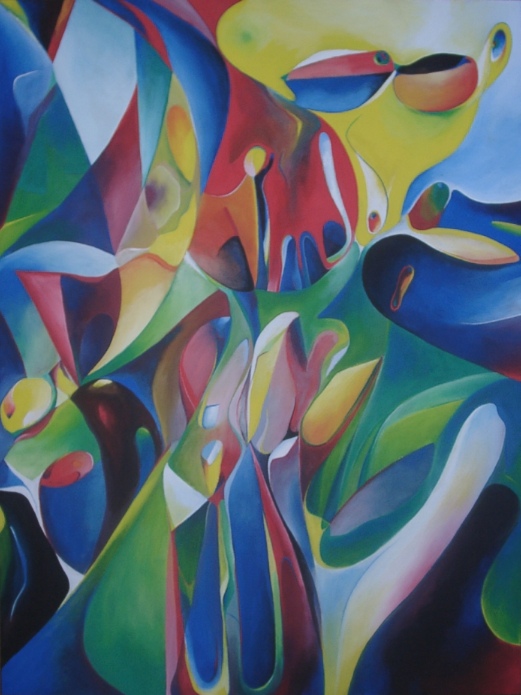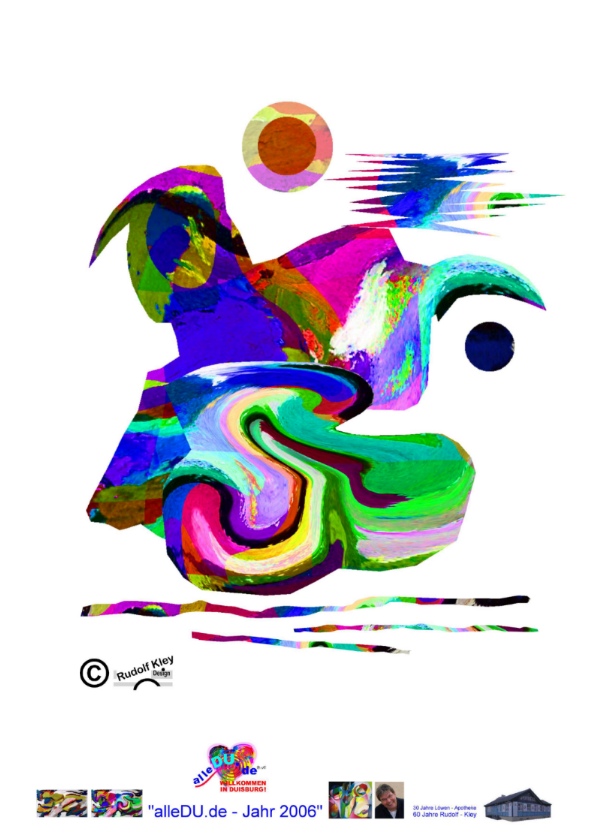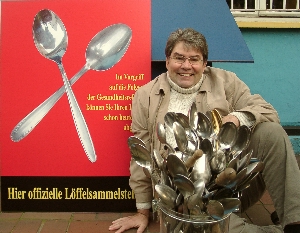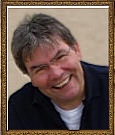


Rudolf Kley
1946
![]()
Rudolf Kley wurde 1946 in Wolfenbüttel geboren.
1951 zog seine Familie nach Duisburg - Meiderich. Dort lebt Rudolf Kley noch heute, und leitet seit 1976 die Löwen-Apotheke in der Bahnhofstraße. 1978 gründet er die Kulturwerkstatt Meiderich, einen Kunstmarkt und eine Galerie, um die Besucher zu dem kreativen Schaffen zu animieren, dass ihn selbst von Jugend an ausfüllt. Wenig später tritt er selbst als Maler ins Rampenlicht.
Rudolf Kley ist nicht nur ein mittlerweile bekannter Maler, er ist auch Aktionskünstler. Viele seiner Kunstaktionen wurden durch politische oder soziale Mißstände und Unzulänglichkeiten ausgelöst, so 2001 - 2003 "Ein Kreuzzug für die Mercatorhalle. Rettet die Seelen der Kinder", oder 2003 - 2004 die Aktion "Löffelabgeben" (Das Gesundheitswesen wird zu Tode reformiert. Die Patienten können es nur retten, wenn sie ihren Löffel abgeben).
Der Erlös seiner spektakulären Großaktionen geht gemeinnützigen Zwecken zu, so der Mülheimer Stattmeter zu Gunsten des Arbeitskreises zur Verminderung der Jugendarbeitslosigkeit, oder auch sein bislang wohl größtes Werk, "1100 Meter Stattgeschichte" (statt Stadtgeschichte) anläßlich des 1100jährigen Stadtjubiläums von Duisburg, welches er z.B. zugunsten der ARD Fernsehlotterie "Ein Platz an der Sonne" in vielen Teilbildern verkaufte. Dieses Bild aus 33 Tapetenrollen wurde 1985 als
"längste abstrakte Bildfolge" ins Guinnessbuch der Rekorde aufgenommen
Immer wieder vertritt Kley vehement den Anspruch auf Freiheit für Kunst und Menschen. Dieser Anspruch kommt nicht abstrakt einher, er verbindet ihn mit tatkräftiger Mithilfe. Seine Werke sind nicht Selbstzweck, sondern immer auch ein sozialer Appell, verbunden mit einem großen Spaßfaktor, indem er sein Publikum sehr direkt in seine Malaktionen mit einbindet. So holt er die Maße für seine "Stattmeter" von beteiligten Persönlichkeiten des öffentlichen Lebens, oder er läßt sich von seinen Mitbürgern alte Luftpumpen spenden, mit denen er ein von Van Gogh in seinem Todesjahr gemaltes Weizenfeld nachbilden will.
Offensichtlich hat ihn Van Gogh sehr inspiriert. Auch Kley malt von Anfang an äußerst farbintensiv. 1991 findet er zu dem von ihn so benannten "NAMEART" Stil, mit dem er seinen Mitbürgern eine Möglichkeit aufzeigt, die Angst vor der weißen Leinwand leicht zu überwinden. Seine Kunst verfolgt keine elitären Ziele sein. Kunst und Qualität von Kunst stellt er als eine Sache der Vereinbarung heraus, der man am besten nicht folgt. Nach seinem Verständnis kann seine Kunst hilfreich für jedermann und jedefrau sein, aber der Adressat seiner Malerei ist eigentlich nur er selbst. Manche Aktionen können ihren berufsbezogenen Ursprung nicht leugnen. Womit sich der Kreis vom Maler zum Apotheker Rudolf Kley wieder schließt.(1993 - 1996: Bellende Kunstwerke und beißender Apotheker. "Jeder Mensch ist ein Placebo!")
http://www.deapo.de/index.htm
http://www.deapo.de/stattmeter.htm
Rudolf Kley was born in 1946 at Wolfenbüttel.
1951 his family moved to Duisburg - Meiderich. Rudolf Kley still lives there today, since 1976as the owner of the "Löwen-Apotheke" (Lions pharmacy) in the "Bahnhofsstraße (railway-street). In 1978 he founded the Cultural Workshop Meiderich, a gallery and art market, where visitors are encouraged to get creative, like he himself is since early childhood. Shortly afterwards Rudolf Kley emerged as a painter himself.
Rudolf Kley is not only a well-known painter today, but also an action artists. Many of his art actions point out political or social shortcomings and inadequacies. Thgus he created in 2001 - 2003 "A crusade for the Mercator Hall. Save the souls of children," or in 2003 - 2004 the campaign "Löffelabgeben" (The health sector is reformed to death. Patients can only save it when they "give their spoons away", which means they quit living, in essence this says: in this system only a dead patient is a good patient, cause being dead saves money).
The money he makes of his spectacular large-scale operations are donated to charitable purposes, like the "Mülheimer Stattmeter", which was used for a committee working to reduce youth unemployment, or his biggest works well so far, "1100 Meter Stattgeschichte" (a wordplay between "statt Geschichte"="contrary to history" and "Stadt-Geschichte"="town history") on the occasion of the 1100 anniversary of the city of Duisburg. This painting was more than one kilometer long and consisted of 33 Wallpaper rolls, which brought him a place in 1985 into the Guinness Book of Records as the 'longest abstract painting". This painting was sold in segments in favor of the ARD television lottery "A Place in the Sun", which donates the money for handicapped persons .
Rudolf Kley always fights vehemently for the right of freedom for art and people. His fight is not abstract,but combined with active help. His works are not art for art, but a social call, combined with a big fun factor, because he interacts with his audience very directly during his action-art. So he picked the measurement for his "Stattmeter" of personalities involved in public life, or he aked his fellow citizens to donate old air pumps, with which he did an installation remembering the wheatfield Van Gogh painted in the year of his death.
Obviously Van Gogh inspired him a lot. From the outset Kley painted with extremely intensive colors. In 1991 he invioted a style he called "NAMEART", which encouraged his fellow citizens to overcome their fear of the white canvas. His art is no elitarian object. Art and quality of art is presented by him as a matter of the agreements best not followed. His opinion of his art can be helpful for every man and every woman, but the addressee of his paintings is actually just he himself. Some of his art show his pharmaceutical roots strongly. Thus the circle from painters to the pharmacist closes again. (1993 to 1996: Bellende Kunstwerke und beißender Apotheker. "Jeder Mensch ist ein Placebo!"- meaning: Barking art and biting pharmacist. "Every human being is a Placebo".)
http://www.deapo.de/index.htm
http://www.deapo.de/stattmeter.htm
|
To the galleries Artists A-Z Artists by year of birth Search by picture Search by portrait Impressum Sitemap |
